Font Statistics (Key Trends and Insights 2024)
04/22/2024

At a Glance: Font Statistics
- The global font and typeface market was valued at $965.4 million in 2021 and is projected to reach $1332.99 million by 2031, showing that more people are interested in fonts.
- In North America, the font market's value of $398.34 million in 2021 is expected to grow, increasing its market share from 41.26% to 43.08% by 2028, indicating a strong regional market development.
- Specifically, in the U.S., Venngage’s research highlights Nevada’s unique preference for script fonts, with 10.34% of users choosing this style, which suggests regional variations in font preferences.
- Understanding these preferences, it’s clear that choosing the right fonts can reduce printing costs by up to 77%, showing how picking the right font can save money and affect branding.
- Additionally, studies suggest that fonts that are harder to read, like Monotype Corsiva, can improve comprehension and memory more than simpler fonts like Arial, indicating that font difficulty can positively influence cognitive engagement.
- The widespread use of Google Web Fonts, particularly Open Sans on legal websites, shows how these font choices are also preferred for their clarity and professionalism in business and legal environments.
Font Market Size and Growth
The font and typeface market is growing fast and is expected to be worth a lot more in the next ten years:
- The global font and typeface market was valued at $965.4 million in 2021.
- Projections suggest the market will reach $1332.99 million by 2031.
Global Font & Typeface Market Size (From 2020 to 2031)
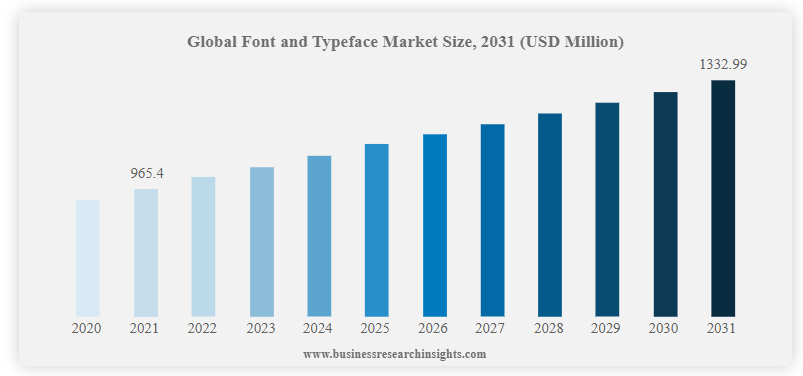
Regional insights provide a closer look at market dynamics:
- North America: The font and typeface market was valued at US$ 398.34 million in 2021. With a market share of 41.26% in the same year, it is forecasted to grow to 43.08% by 2028, marking a modest CAGR of 0.28%.
- Europe: The market was slightly smaller, valued at US$ 242.81 million. Despite its smaller size compared to North America, Europe plays a crucial role in the global typography landscape, contributing significantly to the diversity and innovation in font design.
- Asia: With a market size of US$ 138.55 million in 2021, Japan represents a key player in Asia, reflecting the region's unique typographic needs and preferences.
Font Usage Stats Across US Regions
Venngage analyzed anonymized user data on their platform to study font preferences, examining more than 50 types of fonts to pinpoint regional favorites across the U.S.
Here's a summary of the key findings:
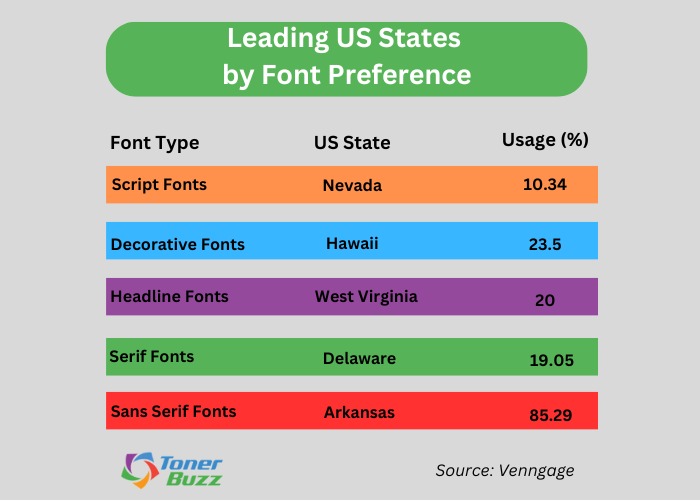
Script Fonts: Preference by State
- Nevada leads in the usage of script fonts, with 10.34% of users opting for handwriting-like fonts, possibly due to its playful content needs.
- West Virginia (10%), Vermont (8.33%) and South Carolina (7.56%) also show a higher preference for script fonts.
Decorative Fonts: Popularity Across States
- Hawaii stands out with 23.5% of users favoring decorative fonts, likely influenced by its significant tourism industry.
- Following Hawaii in this preference are West Virginia (20%), Nebraska (19.23%), and Delaware (19.05%).
Headline Fonts: State and City Preferences
- West Virginia has the highest usage of headline fonts among states, with 20% of users choosing bold fonts for their visuals.
- In cities, Philadelphia, PA tops the list with 11.13% preference for headline fonts, reflecting the city's bold character.
Serif Fonts
- Delaware leads the rankings, with 19.05% of its users preferring serif fonts.
- Nebraska, at 17.31%, and Vermont, with 16.67%, come in second and third, respectively.
Sans Serif Fonts
- Arkansas, the state with the highest preference for sans serif fonts, had just 85.29% of its users opting for this font group.
- Utah and New Mexico followed, with user preferences at 84.91% and 83.94% for sans serif fonts.
Fonts Impact on Branding and Costs
The selection of fonts significantly affects branding and operational costs:
- Choosing the right font can lead to up to 77% savings in printing costs, demonstrating the economic impact of font selection.
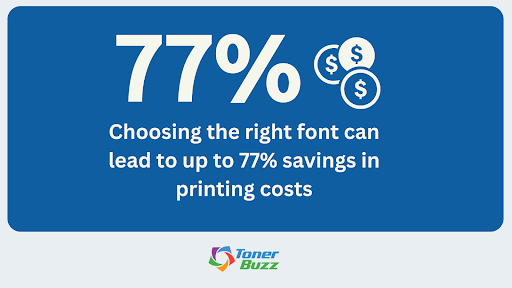
- Three-quarters of Fortune 500 companies choose Sans Serif fonts for their logos, and 19% exclusively use Serif fonts.
Serif vs. Sans Serif Fonts
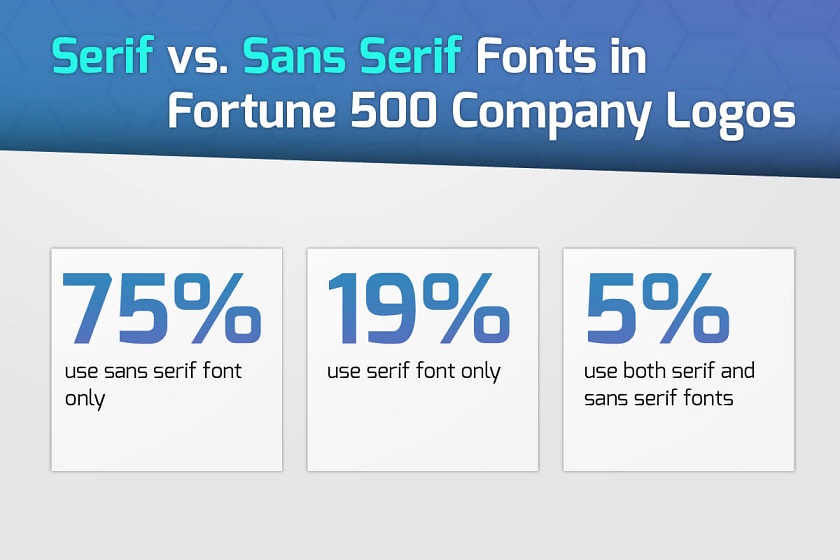
Source: EPCGroup
- Only a small group, around 5%, use a combination of serif and sans serif fonts.
Font Statistics: Readability, Preferences, and Impact
Fonts are more than just visual elements; they have a profound effect on how we understand and remember information.
Looking back at previous studies shows just how deep this influence goes.
Fonts and Their Influence on Memory
A 2013 study by French and others showed that when people read in a harder-to-read font like Monotype Corsiva, they understood the text better than when they read in an easier font like Arial. The test scores were 12.8% higher with the difficult font. Even students who are really good at reading and those with dyslexia did better, with scores 11.5% and 19% higher, respectively.
In 2010, Diemand-Yauman, Oppenheimer, and Caighan found that tricky fonts like Comic Sans MS and Bodoni MT made people remember information 13.7% better than the simpler Arial font. This suggests that when a font is a bit harder to read, it might help us remember better.
Also, a study in 2005 by Gasser and others found that serif fonts, which have little lines on the letters like Times New Roman, helped people remember 9% more information than sans serif fonts without those lines, like Arial. This shows that even small details in fonts can make a big difference in how much we remember from what we read.
Font Choices: What Science Says
- Arial vs. Times New Roman Readability: In a study by Wichita State University, Arial was found to be slightly more readable than Times New Roman on computer screens, with Times New Roman being rated on average 0.4 points more difficult to read on a scale from 1 (not readable) to 7 (very easy to read).
- Serif vs. Sans Serif Fonts: Multiple studies, including those focusing on the Latin and Cyrillic alphabets, have found no significant difference in readability between serif and sans serif fonts, challenging the notion that one is inherently better than the other for general reading.
- Road Sign Legibility: A study in the Interdisciplinary Journal of Signage and Wayfinding tested 33 different fonts for legibility on simulated road signs. The top two fonts for distance reading were Gill Sans and Avenir Medium, both sans serif, suggesting a slight preference for sans serif fonts in this context.
- Reading with Age-related Macular Degeneration: A study published in the "Canadian Journal of Ophthalmology" found that participants with age-related macular degeneration could read the smallest words in the serif font Courier, indicating it might be more readable for people with this condition than sans serif fonts like Arial.
Besides these findings, research from the Institute of Science and Technology surveyed font preferences at 208 universities in Turkey. Times New Roman is the top choice, used by 132 universities, which is 54.77%.
| Font Type |
Number of Universities |
Usage (%) |
| Times New Roman | 132 | 54,77 |
| Arial | 22 | 9,13 |
| Calibri | 9 | 3,73 |
| Cambria | 4 | 1,66 |
| Tahoma | 2 | 0,83 |
| Verdana | 2 | 0,83 |
| Helvetica | 1 | 0,41 |
| Bitstream-Charter | 1 | 0,71 |
Web Fonts Statistics
- From an analysis of 1000 websites, it's revealed that 85% prefer using sans-serif fonts on the web, leaving the rest for serif, monospaced, and other types.
- When it comes to font attributes, designers lean towards larger font sizes over heavier weights, with 94% opting for size and 82% for weight.
- Additionally, a significant 76% combine both larger sizes and heavier weights in their designs for emphasis.
Designers Font Size Selection for Headers (by Percentage)
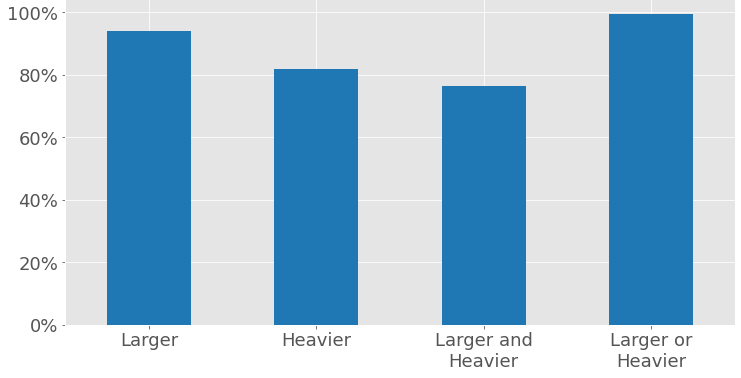
Source: Dribbble
Google Web Fonts
Google Web Fonts, also known as Google Fonts, provides a diverse collection of font families accessible through an interactive web directory.
This service enables the seamless integration of fonts into websites via CSS and Android, making it an important tool for web designers and developers looking to improve their site's typography.
Here are some key statistics about Google Web Fonts:
- Google Web Fonts is used by 11,999,397 websites and is present on 8,375,581 unique domains.
- The top industry verticals using Google Web Fonts include Computers Electronics & Technology (3.90%), Science & Education (3.29%), Arts & Entertainment (2.59%), and Health (1.81%), with the remaining 88.40% spread across various other sectors.
Top Industry Verticals Using Google Web Fonts
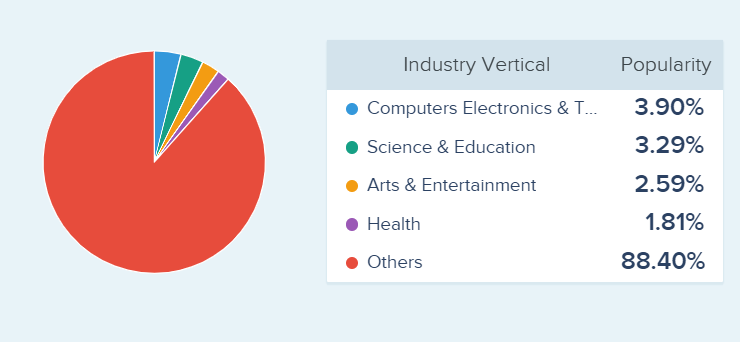
Source: SimilarTech
- Open Sans leads as the most used Google Font on lawyer websites, featured on 14,074 sites, making up 24.504% of the total. Following are Lato and Roboto, with usage on 6,379 and 5,362 websites respectively, highlighting their preference for clarity and professionalism in the legal industry.
- Some of the top websites using Google Web Fonts are google.com, youtube.com, m.youtube.com, drive.google.com, among others, indicating its widespread adoption across major internet platforms.
- The United States leads in the usage of Google Web Fonts with 2,154,948 websites, followed by Japan, the United Kingdom, Russia, and France. Other notable countries include India, Italy, Canada, Germany, and Brazil.
Findings From the Toner Buzz Team
Our team at Toner Buzz explored different font discussions on popular websites.
- Users often associate fonts such as Comic Sans, Papyrus, Lobster, Jokerman, and Bleeding Cowboys with amateurish design.
- On the contrary, fonts like Arial, Times New Roman, Palatino Linotype, Georgia, Helvetica, and Myriad Pro are commonly regarded as professional options.
- Interestingly, authors tend to favor fonts like Arial, Times New Roman, Comic Sans, Calibri, and Consolas.
These insights emphasize the significance of font choice in conveying professionalism and capturing audience's attention.
- https://www.businessresearchinsights.com/market-re...
- https://venngage.com/blog/popular-font-types/
- https://www.epcgroup.net/fortune-500-logo-analysis...
- https://digitalcommons.unomaha.edu/cgi/viewcontent...
- https://www.researchgate.net/publication/335291084...
- https://dribbble.com/stories/2021/04/26/web-design...
- https://www.similartech.com/technologies/google-we...
- https://www.ilovewp.com/resources/wordpress-for-la...
 Calculating arrival date
Calculating arrival date








